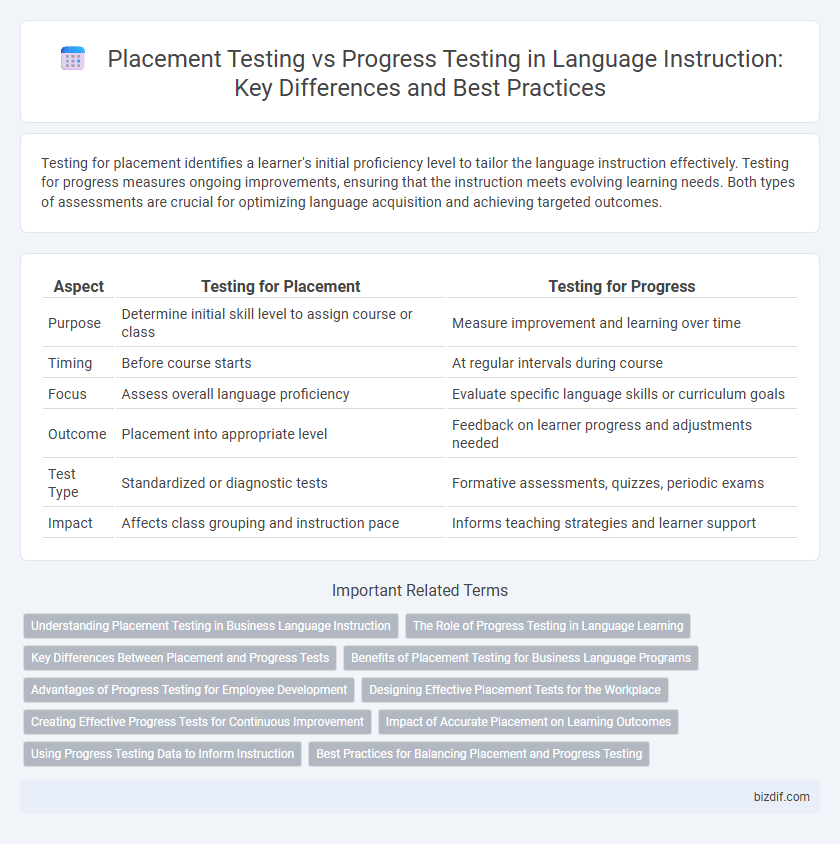Testing for placement identifies a learner's initial proficiency level to tailor the language instruction effectively. Testing for progress measures ongoing improvements, ensuring that the instruction meets evolving learning needs. Both types of assessments are crucial for optimizing language acquisition and achieving targeted outcomes.
Table of Comparison
| Aspect | Testing for Placement | Testing for Progress |
|---|---|---|
| Purpose | Determine initial skill level to assign course or class | Measure improvement and learning over time |
| Timing | Before course starts | At regular intervals during course |
| Focus | Assess overall language proficiency | Evaluate specific language skills or curriculum goals |
| Outcome | Placement into appropriate level | Feedback on learner progress and adjustments needed |
| Test Type | Standardized or diagnostic tests | Formative assessments, quizzes, periodic exams |
| Impact | Affects class grouping and instruction pace | Informs teaching strategies and learner support |
Understanding Placement Testing in Business Language Instruction
Placement testing in business language instruction evaluates a learner's existing proficiency to assign appropriate course levels, ensuring targeted skill development and efficient resource allocation. This process uses standardized assessments to measure grammar, vocabulary, and industry-specific communication skills relevant to corporate environments. Regular placement testing enhances learner engagement by aligning instruction with current abilities and business communication demands.
The Role of Progress Testing in Language Learning
Progress testing plays a crucial role in language learning by continuously evaluating a learner's improvement over time and identifying specific skill areas needing reinforcement. Unlike placement tests that determine initial proficiency levels, progress tests provide actionable feedback to tailor instruction and motivate sustained engagement. This targeted assessment fosters incremental development in vocabulary, grammar, pronunciation, and comprehension essential for mastering a new language.
Key Differences Between Placement and Progress Tests
Placement tests evaluate a learner's existing language proficiency to assign an appropriate course level, emphasizing diagnostic accuracy and initial skill assessment. Progress tests measure ongoing development and skill acquisition during the instruction period, focusing on tracking improvements in vocabulary, grammar, and comprehension. Key differences include purpose, timing, and content scope, with placement tests guiding initial placement and progress tests informing instructional adjustments.
Benefits of Placement Testing for Business Language Programs
Placement testing in business language programs ensures learners start at the appropriate proficiency level, improving engagement and learning efficiency. Accurate placement prevents frustration from overly difficult material and boredom from content that is too easy, optimizing resource allocation. Tailored instruction based on placement results accelerates progress and increases overall program effectiveness.
Advantages of Progress Testing for Employee Development
Progress testing provides continuous insights into employee language proficiency growth, enabling tailored instruction that addresses individual learning needs. This method supports ongoing skill reinforcement, which enhances retention and practical application in workplace communication. Regular progress assessments foster motivation and accountability, driving sustained development and improved performance.
Designing Effective Placement Tests for the Workplace
Designing effective placement tests for the workplace requires assessing employees' existing language skills to tailor training appropriately, ensuring productivity from training onset. Placement tests should measure job-specific vocabulary, grammar, and communication tasks relevant to workplace scenarios, enabling accurate skill level classification. Utilizing adaptive testing methods and real-world simulations enhances the precision of placement, improving overall language program outcomes.
Creating Effective Progress Tests for Continuous Improvement
Effective progress tests in language instruction measure learners' development by targeting specific skill areas such as vocabulary, grammar, listening, and speaking. These assessments use formative feedback mechanisms to identify strengths and weaknesses, guiding tailored instructional adjustments that enhance language acquisition. Continuous improvement is achieved through regularly designed progress tests that align closely with curriculum goals and real-world language use scenarios.
Impact of Accurate Placement on Learning Outcomes
Accurate placement testing significantly enhances learning outcomes by ensuring students begin instruction at an appropriate proficiency level, reducing frustration and accelerating skill acquisition. Proper alignment of language courses with learners' existing abilities fosters motivation and sustained engagement, leading to measurable improvements in language competence. Data-driven placement decisions contribute to more efficient resource allocation, maximizing instructional effectiveness and overall student success.
Using Progress Testing Data to Inform Instruction
Progress testing data provides detailed insights into students' language development over time, allowing instructors to tailor lessons that address specific gaps and reinforce mastered skills. Unlike placement tests, which determine initial proficiency, progress tests track ongoing improvement, enabling dynamic adjustments to instructional strategies and targeted interventions. Utilizing this data effectively enhances differentiated instruction and promotes more personalized language learning outcomes.
Best Practices for Balancing Placement and Progress Testing
Effective language instruction relies on balancing placement tests that accurately assess learners' initial proficiency with progress tests that monitor ongoing development. Best practices include using adaptive placement assessments for precise class placement and employing formative progress evaluations to tailor instruction and provide timely feedback. Integrating data from both test types supports personalized learning pathways and maximizes language acquisition outcomes.
Testing for placement vs Testing for progress Infographic

 bizdif.com
bizdif.com